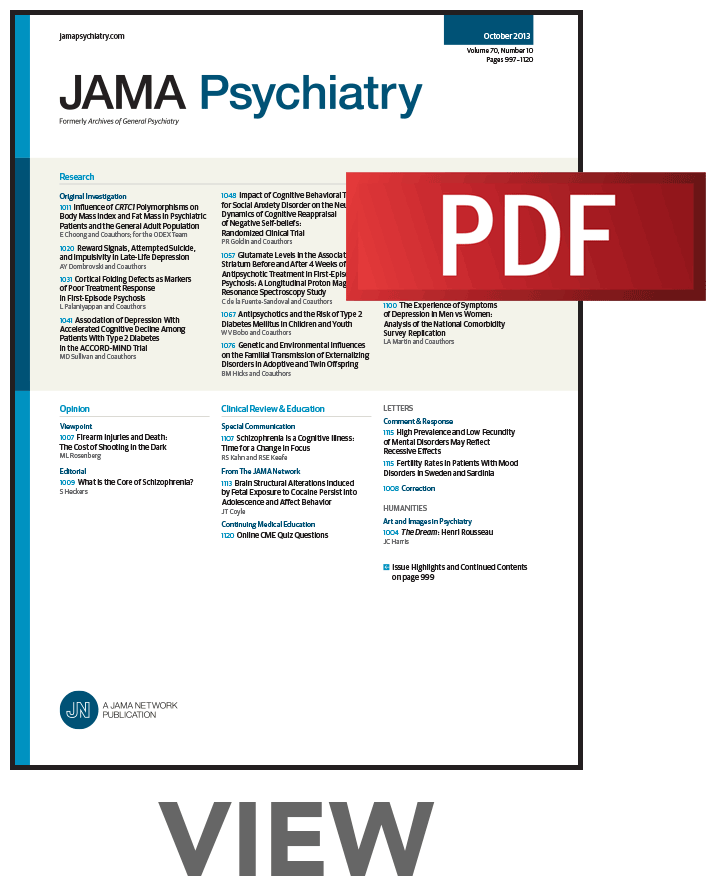Genetic Architecture and Risk of Childhood Maltreatment Across 5 Psychiatric Diagnoses.
IF 17.1
1区 医学
Q1 PSYCHIATRY
引用次数: 0
Abstract
Importance Childhood maltreatment (CM) is associated with psychiatric disorders. The underlying mechanisms are complex and involve genetics. Objective To investigate the polygenic architecture of CM-exposed individuals across psychiatric conditions and if genetics modulates absolute CM risk in the presence of high-impact risk factors such as parental psychiatric diagnoses. Design, Setting, and Participants The population-based case-cohort iPSYCH was used to analyze 13 polygenic scores (PGS) in CM-exposed individuals across 5 psychiatric International Statistical Classification of Diseases and Related Health Problems, Tenth Revision (ICD-10) diagnoses benchmarked against controls. Individuals were stratified into PGS quantiles, and absolute CM risk was calculated using Cox regression. Sex-specific analyses were also performed. Data were analyzed from June 2022 to December 2024. Exposures PGS of phenotypes of psychiatric disorders, CM, educational attainment, and substance use. Main Outcomes and Measures PGSs were generated using summary statistics from genome-wide association studies of phenotypes representing psychiatric disorders, CM, educational attainment, and substance use and tested for their association with CM across psychiatric disorders. Results This study included 102 856 individuals (mean [SD] age, 22.6 [7.1] years; 54 918 male [53.4%]) 8 to 35 years old. A total of 2179 CM-exposed individuals were analyzed across individuals with attention-deficit/hyperactivity disorder (ADHD; n = 22 674), autism (n = 18 941), schizophrenia (n = 6103), bipolar disorder (n = 3061), depression (n = 28 896), and controls (n = 34 689). PGSs for ADHD and educational attainment were associated with CM across all psychiatric diagnoses. The absolute CM risk was increased in the highest PGS groups, eg, for ADHD, the absolute CM risk was 5.6% in the highest ADHD-PGS quartile whereas it was only 3.3% in the lowest ADHD-PGS quartile (hazard rate ratio quantile 4 vs quantile 1 = 1.81; 95% CI, 1.47-2.22). CM risk was more than twice as high for children with parents with a psychiatric diagnosis (5.7%) than for children with parents without a psychiatric diagnosis (2.5%), but even in the presence of this risk factor, individuals could still be stratified into risk groups based on their genetics. No genetic differences between CM-exposed males and females were observed, but there were striking sex differences in absolute CM risk, which reached 5.6% for females in the highest ADHD-PGS quartile and 2.0% for males. Conclusions and Relevance Results of this case-control study suggest that individuals with high ADHD-PRS and/or low educational attainment-PRS had an associated elevated risk of CM. Extra attention should be given to individuals at high risk for CM across all 5 psychiatric diagnoses, ie, females with a high ADHD-PGS and/or a parent diagnosed with a psychiatric disorder.5种精神病诊断中儿童虐待的遗传结构和风险。
儿童虐待(CM)与精神疾病有关。潜在的机制是复杂的,涉及到遗传学。目的探讨CM暴露个体在精神疾病中的多基因结构,以及在父母精神诊断等高影响因素存在的情况下,遗传是否会调节CM的绝对风险。设计、环境和参与者基于人群的病例队列iPSYCH用于分析cm暴露个体的13个多基因评分(PGS),这些个体来自5种精神病学《国际疾病和相关健康问题统计分类》第十版(ICD-10)诊断,以对照为基准。将个体按PGS分位数分层,使用Cox回归计算CM的绝对风险。还进行了性别分析。数据分析时间为2022年6月至2024年12月。暴露于精神疾病、CM、受教育程度和物质使用的表型。主要结局和测量方法通过对精神疾病、CM、受教育程度和物质使用表型的全基因组关联研究的汇总统计数据生成gss,并测试它们与精神疾病中CM的关联。结果本研究纳入102 856例患者(平均[SD]年龄22.6[7.1]岁;54 918名男性[53.4%]),年龄8 ~ 35岁。共分析了2179名cm暴露个体的注意缺陷/多动障碍(ADHD;N = 22 674)、自闭症(N = 18 941)、精神分裂症(N = 6103)、双相情感障碍(N = 3061)、抑郁症(N = 28 896)和对照组(N = 34 689)。在所有精神科诊断中,ADHD和受教育程度的pgs与CM相关。在PGS最高的组中,绝对CM风险增加,例如ADHD, ADHD-PGS最高四分位数的绝对CM风险为5.6%,而ADHD-PGS最低四分位数的绝对CM风险仅为3.3%(风险率比分位数4 vs分位数1 = 1.81;95% ci, 1.47-2.22)。父母有精神病诊断的儿童患CM的风险(5.7%)是父母没有精神病诊断的儿童(2.5%)的两倍多,但即使存在这种风险因素,个体仍然可以根据其遗传学划分为风险组。CM暴露的男性和女性之间没有遗传差异,但绝对CM风险存在显著的性别差异,在ADHD-PGS最高的四分位数中,女性的绝对CM风险为5.6%,男性为2.0%。结论和相关性本病例对照研究的结果表明,高ADHD-PRS和/或低教育程度- prs的个体具有相关的CM风险升高。应特别关注所有5种精神疾病诊断中CM高风险的个体,即患有高度ADHD-PGS的女性和/或父母被诊断患有精神疾病。
本文章由计算机程序翻译,如有差异,请以英文原文为准。
求助全文
约1分钟内获得全文
求助全文
来源期刊

JAMA Psychiatry
PSYCHIATRY-
CiteScore
30.60
自引率
1.90%
发文量
233
期刊介绍:
JAMA Psychiatry is a global, peer-reviewed journal catering to clinicians, scholars, and research scientists in psychiatry, mental health, behavioral science, and related fields. The Archives of Neurology & Psychiatry originated in 1919, splitting into two journals in 1959: Archives of Neurology and Archives of General Psychiatry. In 2013, these evolved into JAMA Neurology and JAMA Psychiatry, respectively. JAMA Psychiatry is affiliated with the JAMA Network, a group of peer-reviewed medical and specialty publications.
 求助内容:
求助内容: 应助结果提醒方式:
应助结果提醒方式:


